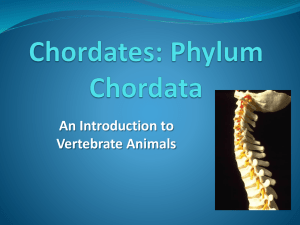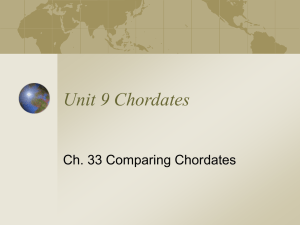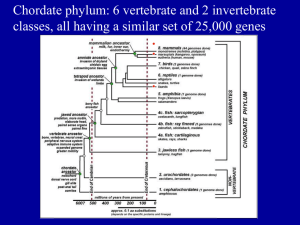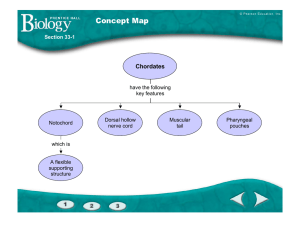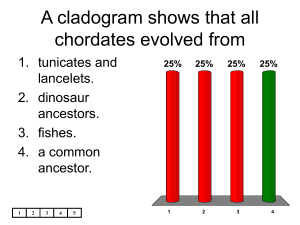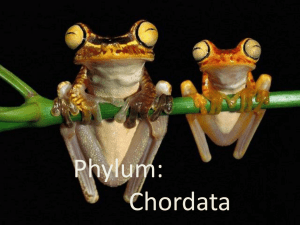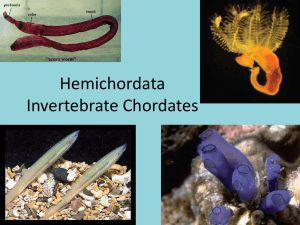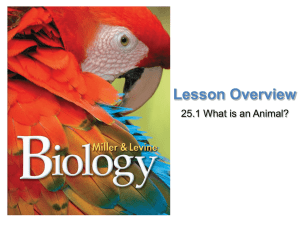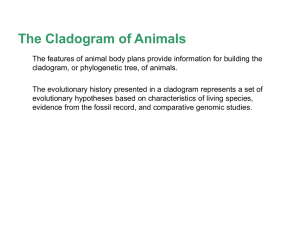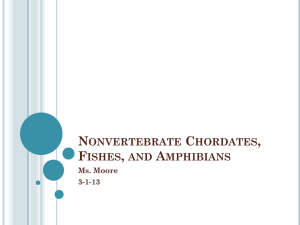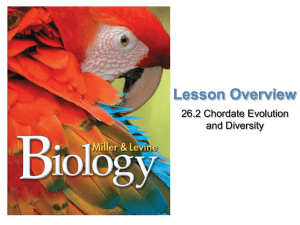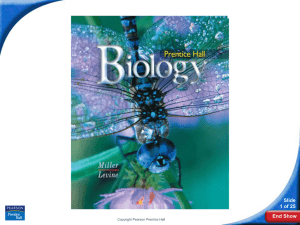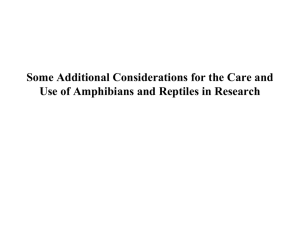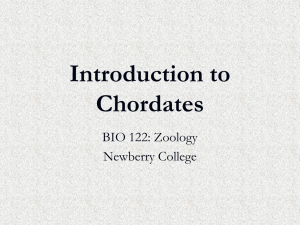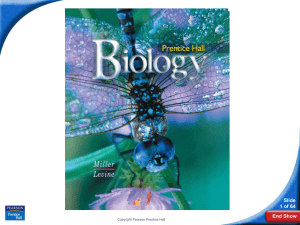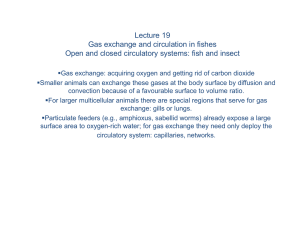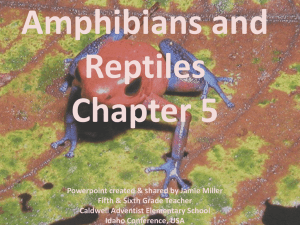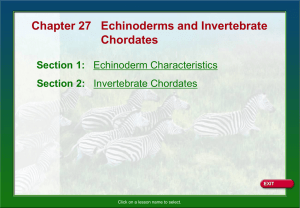Comparing Chordates Notes
advertisement
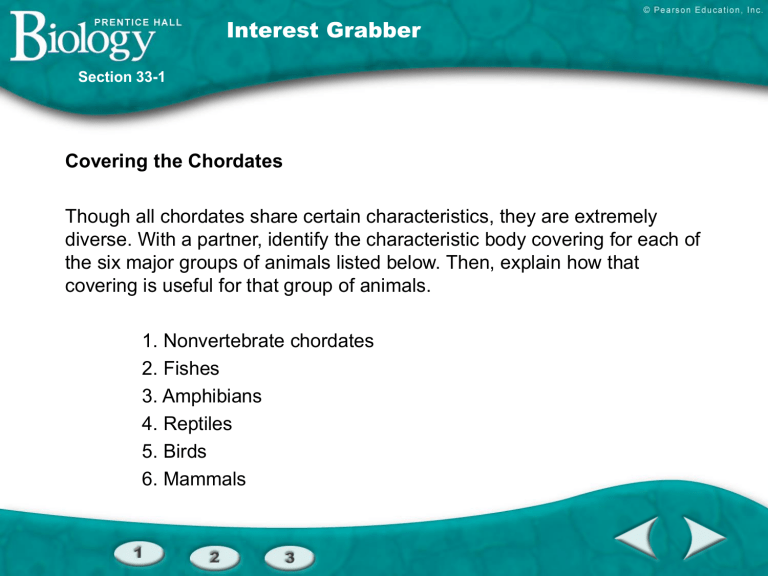
Interest Grabber Section 33-1 Covering the Chordates Though all chordates share certain characteristics, they are extremely diverse. With a partner, identify the characteristic body covering for each of the six major groups of animals listed below. Then, explain how that covering is useful for that group of animals. 1. Nonvertebrate chordates 2. Fishes 3. Amphibians 4. Reptiles 5. Birds 6. Mammals Section Outline Section 33-1 33–1 Chordate Evolution A. Chordate Origins B. The Chordate Family Tree C. Evolutionary Trends in Vertebrates 1. Adaptive Radiations 2. Convergent Evolution D. Chordate Diversity Concept Map Section 33-1 Chordates have the following key features Notochord which is A flexible supporting structure Dorsal hollow nerve cord Muscular tail Pharyngeal pouches Figure 33–2 A Cladogram of Chordates Section 33-1 Nonvertebrate chordates Jawless fishes Cartilaginous fishes Bony fishes Amphibians Reptiles Birds Mammals Figure 33–4 Diversity of Chordates Section 33-1 Nonvertebrate chordates (4%) Mammals (8%) Birds (18%) Reptiles (14%) Amphibians (9%) Fishes (47%) Interest Grabber Section 33-2 How Hot Is Too Hot? As you know, your body, for the most part, maintains a constant temperature. Enzymes in your body function most efficiently at a temperature that is very close to your body temperature. 1. What is the body’s normal temperature? 2. What happens to your body’s temperature when you have a viral or bacterial infection? What purpose might this serve? 3. What do you think would happen if your body temperature radically increased or decreased from its normal level? Explain why. Section Outline Section 33-2 33–2 Controlling Body Temperature A. Body Temperature and Homeostasis 1. Ectothermy 2. Endothermy B. Comparing Ectotherms and Endotherms C. Evolution of Temperature Control Temperature Control in Chordates Body Temperature (°C) Section 33-2 Environmental Temperature (°C) Interest Grabber Section 33-3 How Do They Do That? As you have read, the problems faced by a land-dwelling chordate are very different from those faced by a water-dwelling chordate. Thus, the characteristics of these chordates are also quite different. Choose two chordates—one that lives in the water and one that lives on land. Construct a compare/contrast table that shows the similarities and differences in feeding, respiration, movement, and circulation between these two chordates. Section Outline Section 33-3 33–3 Form and Function in Chordates A. Feeding B. Respiration 1. Gills 2. Lungs C. Circulation 1. Single- and Double-Loop Circulation 2. Heart Chambers D. Excretion E. Response F. Movement G. Reproduction Compare/Contrast Table Section 33-3 Comparing Functions of Chordates Function Nonvertebrate Chordates Fishes Amphibians (adult) Reptiles Birds Respiration Gills and diffusion Gills/air sacs Simple lungs and skin Lungs Lungs (tubes Lungs and air sacs; (alveoli) one-way flow) Circulation No true chambers Single loop; 2 Double loop; chambers 3 chambers Double loop; 3 chambers Double loop; 4 chambers Double loop; 4 chambers Excretion Gills and gill slits Kidney and gills Kidney Kidney Kidney Response Simple; mass Cephalization; Cephalization; Cephalization; Cephalization; Cephalization; of nerve cells small small small large large cerebrum cerebrum cerebrum cerebrum cerebrum Kidney and gills Mammals Compare/Contrast Table continued Section 33-3 Comparing Functions of Chordates Fishes Amphibians Amphibians (adult) (adult) Reptiles Birds Mammals Muscles on either side of backbone Limbs stick out sideways; muscles and ligaments Limbs point directly toward ground; muscles and ligaments Upper limbs are wings; 2 feet; muscles and ligaments 2 or 4 legs; walk with legs straight under them; muscles and ligaments Reproduction External fertilization External fertilization External fertilization Internal fertilization; shelled egg Internal fertilization; shelled egg Internal fertilization and development Temperature Ectothermic Control Ectothermic Ectothermic Ectothermic Endothermic Endothermic Function Movement Nonvertebrate Chordates Muscles, no bones Figure 33–8 The Digestive Systems of Vertebrates Section 33-3 Esophagus Stomach Intestine Liver Gallbladder Pancreas Cloaca Crop Gizzard Cecum Rectum Shark Salamander Lizard Pigeon Cow Figure 33–10 Vertebrate Lungs Section 33-3 Nostrils, mouth, and throat Trachea Lung Air sac Salamander Lizard Primate Pigeon Figure 33–11 The Circulatory Systems of Vertebrates Section 33-3 Single-Loop Circulatory System FISHES Double-Loop Circulatory System MOST REPTILES CROCODILIANS, BIRDS, AND MAMMALS Figure 33–11 The Circulatory Systems of Vertebrates Section 33-3 Single-Loop Circulatory System FISHES Double-Loop Circulatory System MOST REPTILES CROCODILIANS, BIRDS, AND MAMMALS
